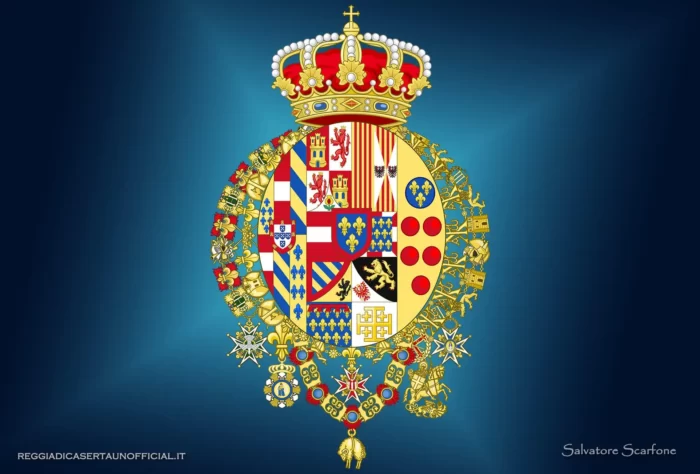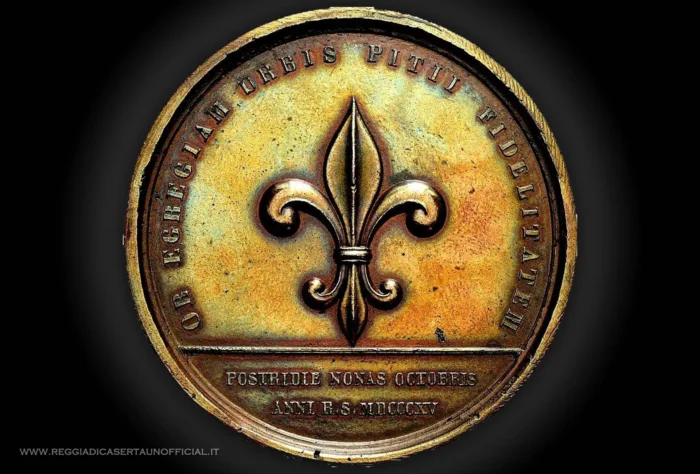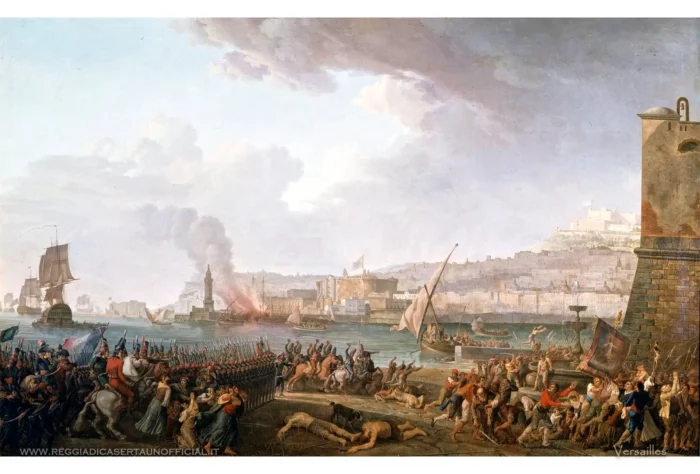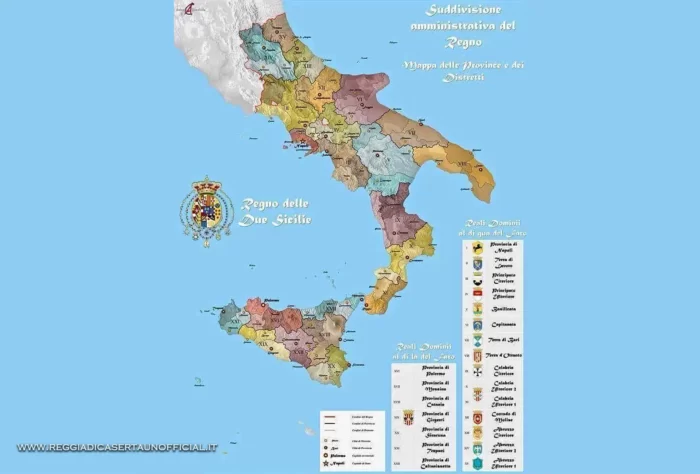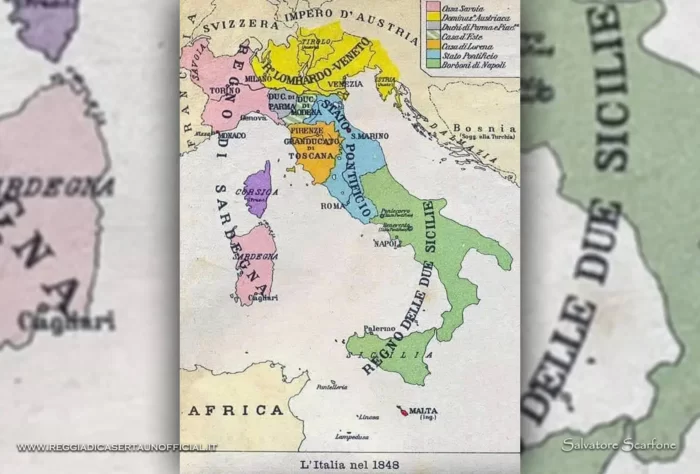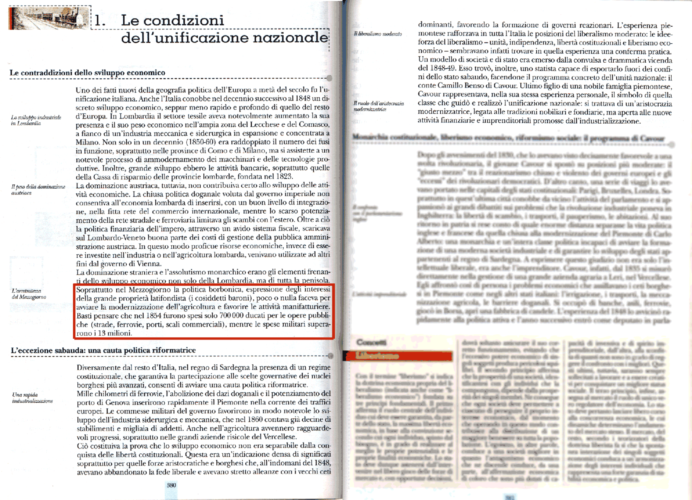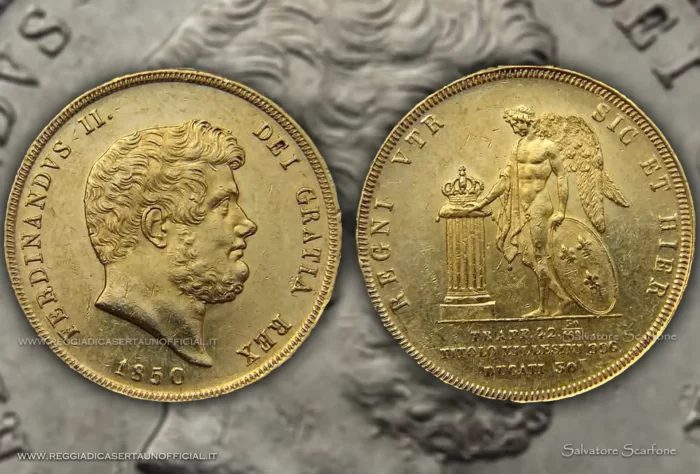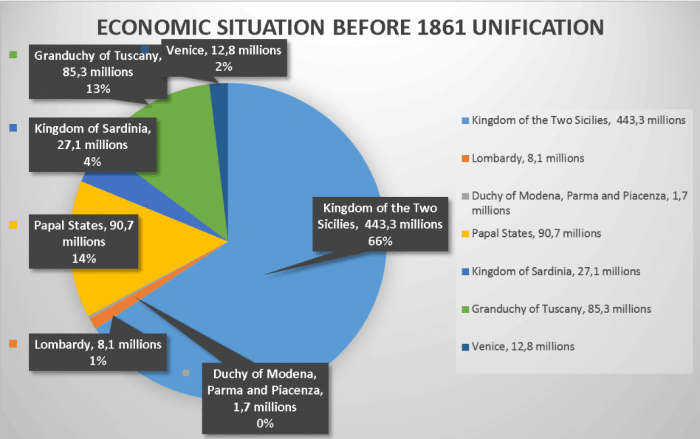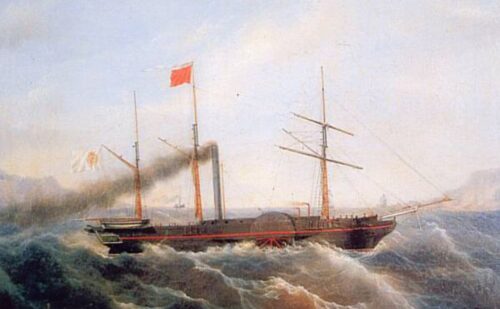The Kingdom of the Two Sicilies
Was the Kingdom of the Two Sicilies, the richest in the peninsula, really retrograde or was it defamed to justify the pre-unification attack?
The Kingdom of the Two Sicilies, also known as the Kingdom of Naples and the Kingdom of Sicily, was one of the most important states at European level before unification. Its strategic geographical position and its economic wealth made it a strategic target in the Mediterranean. Was the Kingdom of the Two Sicilies, the richest on the peninsula, really retrograde or was it defamed to justify the pre-unification attack?
The National Anthem of the Kingdom of the Two Sicilies
The anthem of the Kingdom of the Two Sicilies was created in 1787 by Giovanni Paisiello, at the request of King Ferdinand IV. This piece of music, more than any other, represents the feeling of the nation, its strength and its power, and therefore justifies its choice as the national anthem of the Kingdom.
History of the Kingdom of the Two Sicilies
The Bourbon dynasty exercised its dominion over the territory of Southern Italy for a long period, ranging from 1734 to 1860. During this period, the Bourbons ruled over a vast region that included the current regions of Southern Italy, maintaining the control over important cities such as Naples, Palermo and other areas of the South. During their reign, the Bourbons carried out significant political, social and economic transformations that left an indelible mark on the history of Southern Italy. The presence of the Bourbons had a profound impact on the culture and identity of the southern regions, leaving a legacy that is still reflected today in local gastronomy, architecture and traditions.
The origins: the Kingdom of Naples
King Charles of Bourbon
Charles of Bourbon is commonly recognized as the first King of Naples of the Bourbon dynasty and the principal restorer of the Kingdom. However, it should be noted that the first ruler of the dynasty to rule in Southern Italy was his father Philip V, who ascended the throne of Madrid in 1700. During the long War of the Spanish Succession, Philip lost the viceroyalty of Naples and Sicily in 1707 to of the Habsburgs of Austria, despite his victory in the war and his effective control over Spain. The Habsburgs maintained control of Naples and Sicily until 1734, when Charles of Bourbon, son of Philip V and his second wife Elisabetta Farnese, regained the Neapolitan viceroyalty with the diplomatic support of his mother. Charles thus became the effective ruler and assumed the title of Charles King of Naples, restoring the autonomy of the Kingdom of Naples and making it an independent and sovereign nation.
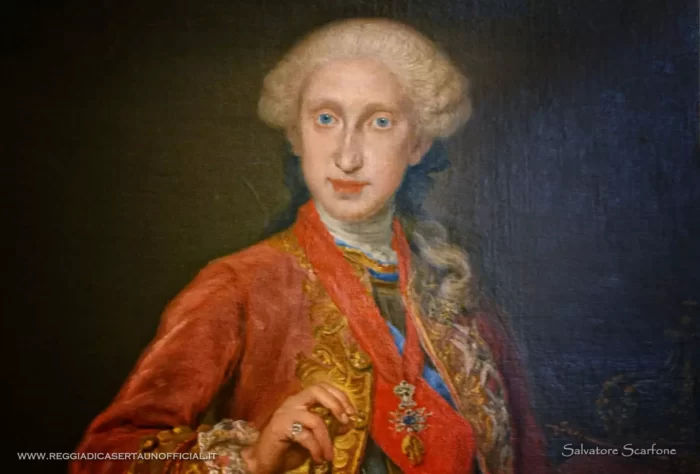
King Charles of Bourbon (also called Charles III of Bourbon and Spain)
King Ferdinand of Bourbon
Charles of Bourbon abdicated the Throne of Naples in 1759 to ascend to that of Madrid, separating the two crowns. His son Ferdinand, only eight years old, was named heir to Naples and entrusted to a Council of Regency which continued the reformist policy initiated by Charles of Bourbon in collaboration with Madrid. This period was characterized by the famous Bourbon reformism, which Ferdinand continued until the advent of the revolution. An example of this reformist policy was the Statute of San Leucio, considered the first form of socialism and equality between men and women.
In 1768 Ferdinand married Maria Carolina of Austria, daughter of Empress Maria Theresa of Habsburg, and with her he had 18 children. His wife exerted a great influence on Ferdinand’s political choices, especially after the birth of their firstborn Francesco. The clash with Tanucci led to his replacement with Prince John Acton, who brought the Kingdom under British influence. Despite the break with Madrid, the reform process continued, influenced by the monarchs’ parents, Charles of Bourbon and Maria Teresa.
Due to the French Revolution, the reform policy in Italy suffered an interruption due to the change in attitude of the Neapolitan rulers towards political innovations. After 1794, Ferdinand and Maria Carolina realized that the Enlightenment intellectuals and Freemasons were plotting against them. Despite some attempts at conciliation with the French Republic, Ferdinand joined the international anti-revolutionary and anti-Napoleonic coalitions, remaining faithful to the alliance with the English.
1799: the Neapolitan Republic
Since 1796, the young Napoleon Buonaparte gradually invaded and conquered most of the territories of the Italian states, everywhere encountering the spontaneous armed revolt of the Italian populations who rose up in defense of the legitimate secular sovereigns and governments.
In February 1798 the revolutionary armies invaded the Papal States, causing the flight of Pius VI and establishing the Jacobin Roman Republic. In November, Ferdinand, aware that the Napoleonics were now only missing the Kingdom of Naples to complete the conquest of Italy, decided to wage war on the French.
Ferdinand’s proclamation of 8 December 1798 incited his subjects to resist armedly against the French. Thousands of people, men, women and elderly people, followed the proclamation and fought for six months until the Kingdom was reconquered. However, the French conquered Naples on 22 January 1799, massacring 10,000 insurgents (the famous Lazarus). In the meantime, the Court had moved to Palermo and King Ferdinand had left Naples under the control of a council of aristocrats and the Royal Vicar Pignatelli.
In Naples, the Republic was established by the Jacobins, who attempted to implement republican reforms in the provinces, but with limited results. Popular discontent and loyalty to the dynasty were evident everywhere, manifesting themselves in an increasingly threatening way.
Cardinal Fabrizio Ruffo of the Princes of Scylla presented a bold project to the King of Naples to reconquer the Kingdom of Naples with the support of the local populations. Despite initial doubts, the King granted the Cardinal the title of King’s Vicar for the Kingdom of Naples and a single ship with seven men. However, Ruffo managed to mobilize an army of tens of thousands of volunteers from all over the Kingdom, founding the “Christian and Royal Army” in the name of Ferdinand IV. This army triumphed in Naples on 13 June 1799, restoring the Bourbon monarchy.
King Ferdinand and Queen Maria Carolina returned to the Throne of Naples in triumph, obtaining the full consent of the populations who had fought for them. From 1805 they reigned in peace, but were then hit by the Napoleonic storm.
Taurel Jean Jacques François – Entry into Naples of the French army commanded by General Championet 1799 (Palace of Versailles)
Napoleonic domination
In 1806 Napoleon conquered the Kingdom of Naples and placed his brother Giuseppe on the throne. The Royal family moved to Palermo and the Sanfedist guerrilla war began, which lasted until 1810 and in particular in Calabria until the Restoration.
In 1808, Napoleon issued a decree from Paris ordering Joseph to go to Madrid, while appointing Joachim Murat, his brother-in-law, as ruler of the Kingdom of Naples. Murat remained on the throne until 1815, when the European Restoration occurred. However, in 1815, Murat, desperate for the defeat of the restoration forces, attempted a last desperate action by landing in Calabria and encouraging the peasants to rebel armed against the Bourbons. Unfortunately, he was captured and shot in Pizzo Calabro after being incarcerated in the local castle.
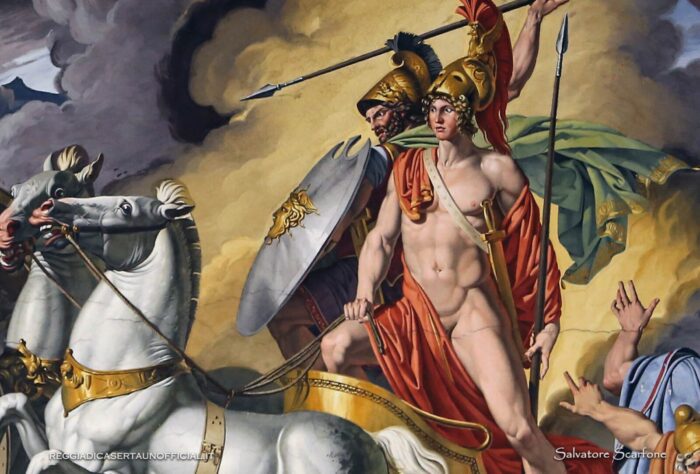
Joachim Murat portrayed as the god Mars in the fresco in the Hall of Mars of the Royal Palace of Caserta
The birth of the Kingdom of the Two Sicilies
King Francis I of the Two Sicilies
Soon…
King Ferdinand II of the Two Sicilies
Soon…
King Francis II of the Two Sicilies
Soon…
The conquest of the Kingdom in 1860
Soon…
The "true" story of the unification of Italy
The history of the Kingdom of the Two Sicilies as we know it today is strictly due to the post-unification historiography of Italy, two totally contradictory stories are told, one official and the other told today by more and more scholars.
Official thesis
According to the official history written in school history books, this Kingdom was culturally and economically underdeveloped and backward, and governed in an abusive manner by the Bourbons. In old books it is not uncommon to use a very ironic and derogatory tone towards the Bourbons, and in many dictionaries, including current ones, the word Bourbon has the meaning of retrograde, backward. The history of unification (simplifying) tells that Garibaldi with his thousand men toured Italy defeating all the dynasties, freeing the people from the oppressors and creating a united Italy.
Generally our official history books tells just this about the history of the Two Sicilies, and also nothing about the cultural side.
Revisionist thesis
Many intellectuals today describe this Kingdom of the Two Sicilies as the third economic power of Europe, with Naples as the capital of European culture and innovation along with Paris and London. The Kingdom of the Two Sicilies were annexed to the Kingdom of the dynasty Savoy after being invaded without any declaration of war. The Savoys, almost went in bankrupt, were supported by English Freemasonry, which provided men, military equipment and money (to be used to bribe the Bourbon generals), that helped them to invade the very rich Kingdom of the Two Sicilies, which at the time held 60% of all Italian wealth, and was made of gold and silver coins, not paper banknotes.
- The UK did it because the Kingdom of the Two Sicilies, thanks to its central position in the Mediterranean, and its large fleet, it would be greatly benefited from the opening of the new Suez Canal (1869), which allowed direct access to Southeast Asia to no more have to circumnavigate Africa. Naples would become the main commercial hub between Europe and the Indies, an area ruled by UK, and so the UK should have used Naples, a rival State, to go to its Asian areas;
- The Savoys, instead, just done this to take possession of the wealth of the Two Sicilies to avoid bankruptcy, paying off their debts with banks. They were not really interested to Unitification, the Savoy family not even spoke the italian language, but French.
Obviously it is a very controversial story, never officially investigated.
Below you can read a common introduction to the italian unification typical of history school books. In this case there is a description of the general economical conditions of the 1861 pre-unification italian Kingdoms. The first part talks about the northern italy, the highlighted part is the one dedicated to the Kingdom of the Two Sicilies, the remaining talks about the Kingdom of Sardinia. The highlighted part says:
“. . . Especially in Southern Italy the politics of the Bourbon, was expression of interests of the big landowners (so-called barons), and did little or nothing for the modernization of agriculture, and to boost manufacturing activities. Just think that in 1854 only 700. 000 ducats were spent for public works (roads, railways, ports, commercial ports), while military spending exceeded 13 million. “
Video on the truthfulness of the history of the Unification of Italy
Prominent personalities of culture and society support the revisionist thesis on the Unification of Italy, and on the reputation of the Kingdom in general.
TG1 special on the 150th anniversary of unity - Rai TV
Eugenio Scalfari: “Italians hate the state …” – Repubblica TV
Giulio Tremonti, former minister of economy
Paolo Mieli: “Italy has a historiographical debt with the south
The Bourbons today
- Carlo di Borbone (Principe)
- Camilla Crociani (Principessa)
- Maria Carolina di Borbone (Principessa)
- Maria Chiara di Borbone (Principessa)
Documentary about the Kingdom of the Two Sicilies
Journey to the Kingdom of the Two Sicilies. – Ulysses, by Alberto Angela. Rai TV.
Alberto Angela’s documentary, “Journey to the Kingdom of the Two Sicilies”, was broadcast on Rai TV. During the broadcast, Angela takes us on a journey through time through the Kingdom of the Two Sicilies, through historical images, reconstructions and interviews with experts , the program offers a unique and in-depth perspective on an often overlooked historical period, allowing audiences to fully appreciate the richness and diversity of the Kingdom.
The economy
In 1860 the situation of the Kingdom of the Two Sicilies, in front of the other states of the peninsula, was the following, given its wealth and the number of its inhabitants:
- The taxes were lower than those of other states.
- State property and assets of the church represented an enormous wealth, and, taken together, exceeded the goods of the same nature, possessed by other states.
- The public debt, tenuous, was four times lower than that of Piedmont, and much lower than that of Tuscany.
- The number of employees, calculating based on pensions in 1860 was half that in Tuscany and almost half of that in the Kingdom of Sardinia.
- The amount of coinage in circulation, later withdrawn from circulation of the State, was in absolute figure two times higher than that of all other states in the peninsula joined together.
Francesco Saverio Nitti,President of the Council of Ministers of the Kingdom of Italy,in its book “North and South” said that at the time of the introduction of the lira, from The Kingdom of the Two Sicilies were withdrawn 443. 3 million of various coinage coins, of which 424 million were silver coins, accounting for 65. 7% of all circulating coins in the italian peninsula.
The gold ducat of the two Sicilies. The coins of the kingdom were only made of metal: gold, silver and copper.
The reforms
Soon…
The primacies of the Kingdom of the Two Sicilies
The primacies in the XVIII century
- 1732 – the oldest institute of sinology and orientalism in Europe (the Chinese College of Naples).
- 1735 – the first chair of Astronomy and Nautical in Italy entrusted to Pietro De Martino in Naples.
- 1739 – establishment of the first commercial court in Italy.
- 1739 – first breech-loading powder and wind rifle in Italy (Naples, Raimondo de Sangro).
- 1751 – first legislation in Italy on healthcare organisation.
- 1753 – first studies of scleroderma with Carlo Curzio
- 1754 – the first chair of economics in Europe entrusted to Antonio Genovesi in Naples.
- 1759 – first Italian newspaper (Diario Notizioso).
- 1763 – first Italian cemetery for the poor (the “Cimitero delle 366 fossa”, in Naples).
- 1764 – first studies of epidemology in Italy with Michele Sarcone
- 1770 – first “maritime carriage” in Europe (future hovercraft) in Naples (Raimondo de Sangro).
- 1774 – first institution in Italy of the motivation of sentences (Gaetano Filangieri).
- 1777 – first Italian state to establish official diplomatic relations with the Russian Empire.
- 1780 – first register of lawyers in Italy
- 1781 – first modern maritime code (by Michele de Jorio).
- 1782 – first anti-tuberculosis prophylaxis intervention in Italy.
- 1783 – first anti-seismic laws in Italy.
- 1783 – first cemetery in Europe for use by all social classes (Palermo).
- 1787 – birth of the modern female “art of obstetrics” (with Teresa Ployant).
- 1789 – first assignment of “social housing” in Italy (San Leucio near Caserta).
- 1789 – first institution of free health care (San Leucio).
- 1796 – First Italian city to host a consulate of the newborn United States of America (consulate in Naples with John Mathieu).
The primacies in the XIX century
- 1801 – first world discovery of an asteroid: “Ceres Ferdinandea” (Giuseppe Piazzi).
- 1801 – first Mineralogical Museum in the world.
- 1802 – first institution in Italy of “vaccination offices”.
- 1806 – first chair of zoology in Italy.
- 1807 – first modern botanical garden in Italy in Naples.
- 1812 – the first ballet school in Italy annexed to the San Carlo.
- 1813 – first Italian psychiatric hospital (Reale Morotrofio di Aversa).
- 1817 – first law in Italy for the management and reception of immigrants.
- 1818 – first steamship in the Mediterranean (Ferdinand I).
- 1818 – first Italian school for the blind in Naples at the hospice of Saints Giuseppe and Lucia.
- 1818 – first institution of the pension system in Italy (with withholdings of 2% on salaries).
- 1819 – first building built for an Astronomical Observatory in Italy at Capodimonte.
- 1822 – first research and publications of homeopathic medicine in Italy.
- 1828 – first experiments in homeopathic medicine in Italy (Palermo).
- 1830 – first aletoscope, optical machine invented by Raffaele Sacco.
- 1831 – first institution of an unemployment allowance for those unable to work.
- 1832 – first iron suspension bridge in continental Europe over the Garigliano.
- 1832 – first Italian ordinance on waste collection (with separate waste collection).
- 1832 – first establishment in Italy of an institution for statistical studies (Central Statistics Department with the Statistics Journal of Sicily).
- 1832 – fewer insane people than the population in Europe (1 in 10,404 in the Kingdom of Naples, 1 in 1,000 in France, 1 in 883 in England, 1 in 5,568 in Piedmont).< /li>
- 1833 – highest number of people vaccinated against smallpox in Italy in relation to the population (over one million three hundred thousand people in twenty years).
- 1833 – first cruise ship in Europe (Francis I).
- 1833 – highest longevity rate in Europe (1 nonagenarian for every 117 deaths, 1 centenarian for every 946 deaths, compared to the European average of 1 in 11,996).
- 1835 – first institute
Desired by King Charles of Bourbon, the San Carlo Theatre in Naples it is the most imitated and also the oldest theatre in the world (active since 1737). It revolutionized the world theater architecture by introducing the horseshoe shape and balconies. Every theatre in the world with this shape was inspired by the San Carlo, also, for example, La Scala in Milan, the court theater at Versailles, or the Opera Royale in Paris.
